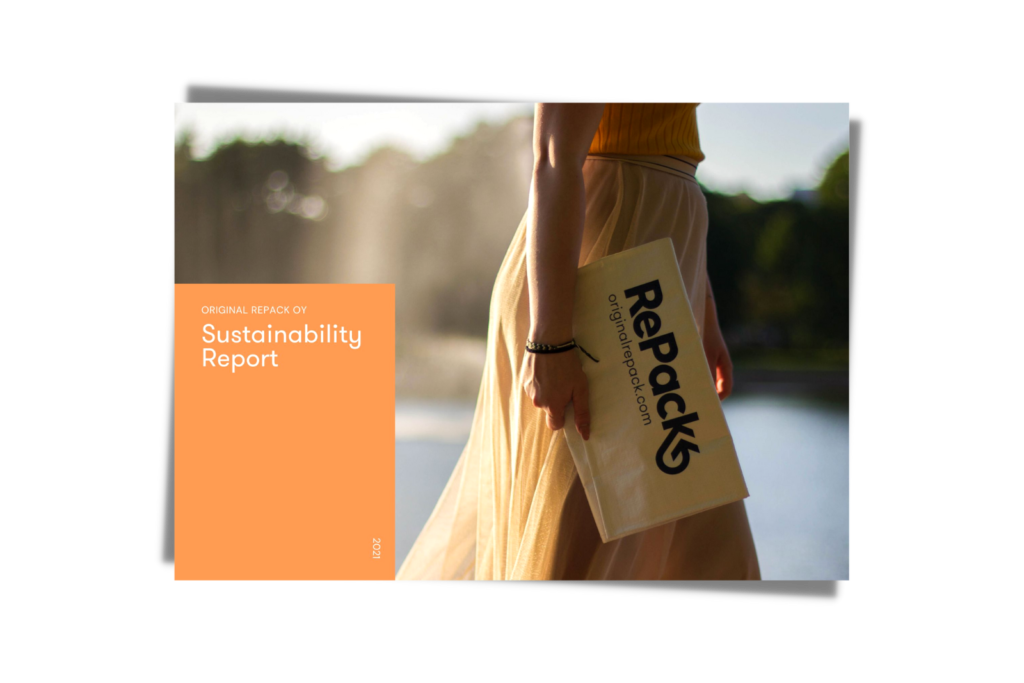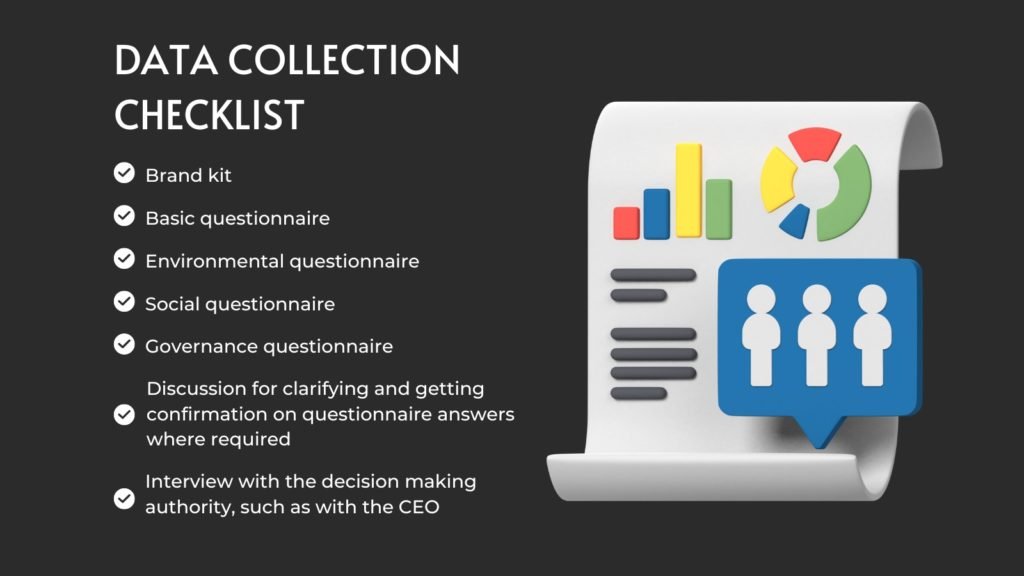Helping RePack publish its first sustainability report: becoming an industry leader in transparency while saving time and resources spent on the process

About RePack – a creative forerunner of the packaging service industry
RePack is a circular packaging service company, whose main products are reusable mailers, RePacks. While operating primarily in Europe, the US, and Canada, for select services they are also globally available. The circular start-up has won several prizes for its intelligent design, as well as for its elegantly simple yet effective low-impact solution for an everyday problem faced by many companies, especially in e-commerce & re-commerce: extra cost and waste created by single-use packaging.

Abundance of extensive ESG data
In the course of business, RePack often receives inquiries from their stakeholders about their sustainable practices and methods, and details regarding the impact of their mailing solutions, especially in cases when companies are considering moving from single-use packaging to RePacks.
As a company Repack has consistently made active efforts to provide sustainability-related data for all its stakeholders. It has done so primarily through its website and via its social media accounts, by means of blog posts, LCA (Life Cycle Assessment) results, and by participating in various studies that map out and document the various benefits of its service.
While all this information and data about the sustainability impacts of RePack’s business was well documented, it still existed separately and there was felt a lack of one single document that could make all this information, and more available in an organized, standardized manner.
Drive for simplicity and clarity
RePack is a company that seeks to keep things neat and simple. Just as their packages are innovatively sleek, and their useability effortless to understand, they wish for their sustainability message to be equally easy to comprehend yet effective in terms of its impact on the recipient. Addressing multiple stakeholder groups at the same time, RePack was looking to communicate its ESG impact in a clear and crisp way where the data and message did not simply get lost under heaps of information.
And this was where sustainability reporting stepped into the picture. A sustainability report provided RePack with a medium for communicating relevant information in a concise way and in line with its brand. As a stand-alone all-inclusive sustainability document, it became the perfect platform to showcase the extensive data already collected and detailed impact assessments all together in a shareable and visually pleasing way. Additionally, by providing an insight into the company’s ESG impact it acted as a compelling selling argument while at the same time complying with the globally recognized and most used sustainability reporting standard, GRI.
What did the sustainability reporting process look like?
Phase 1: Collection of ESG data through questionnaires and interviews
The first step in the reporting process is data collection. In the case of using an external service provider, the most efficient way of collecting necessary ESG data is by allowing the company to perform the data collection in-house with guidance that is easy to follow.
We provided RePack with a set of questionnaires based on the GRI standards, enabling the company to answer the questionnaires based on the data it either already had available or could easily access, and what it wanted to communicate to its stakeholders in particular.

There were in total 4 GRI standards-based questionnaires:
- Basic information about the company, in order to give a well-rounded understanding of the company’s core sustainability performance
- Environmental questionnaire, in order to measure RePacks environmental impacts
- Social questionnaire in order to map out RePack’s social impacts
- Governance questionnaire in order to collect information about the company’s governance structure and systems.
Only the basic level questionnaire was compulsory for responding, in order to ensure that the sustainability report would contain all the necessary basic information about the company alongside fundamental ESG facts and figures, allowing it to comply with the GRI core standard.
All the three other questionnaires, the Environmental, Social and Governance, ESG, were to be answered on a voluntary basis. This approach was chosen because data availability varies significantly between different companies and industries.
The main benefit of the questionnaire-based model is that the company gets to determine the material data they wish to share, while simultaneously being made aware of potential ESG-related information that might be sought by their stakeholders in the future. This allows them foresight and the opportunity for long-term planning in terms of collecting information from systems and processes that have as yet not enough or missing data.
Once the questionnaires were filled in, we conducted an interview with RePack’s Co-Founder and Chief Executive Officer Jonne Hellgren to appear in the sustainability report as a Q&A-styled message from the CEO, showcasing his view on the company’s sustainability performance and giving the reader a perspective on the bigger picture of the company’s sustainability aspirations.
How long does it take for a company to fill in the GRI standard-based questionnaires?
On average, it takes slightly more time to fill in the questionnaires if the company is doing its first sustainability report, compared to a company with a history of publishing sustainability reports. This is simply because a company with previous experience in sustainability reporting already knows what type of data it will need to provide and has it readily available from previous years, only to be updated if needed. This makes the data collection process faster. Additionally, in comparison, first-time reporting companies have not yet had the opportunity to set up data collection systems that would enable them to provide the reporting period’s sustainability data with just a few clicks.

Phase 2: How does a reporting agency prepare for report drafting?
While RePack was filling in the questionnaires, we got started with the preliminary design of the report. At the very beginning of our cooperation, we had requested for RePack to provide us with their brand kit and access to their visual resources, such as their photo bank including product and company photos, as well as available graphics.
Once we had created the preliminary design and structured skeleton of the sustainability report we drafted preliminary categories and headers that would be relevant for RePack’s industry as a packaging service provider, and that would highlight the sustainability topics especially material to their business.
We also used the opportunity provided by the time to do our own in-depth research concerning RePack as a company, their business model, their cooperation partners, as well as certifications they have, in order for us not only to just understand their business as well as possible but also to collect additional data to support, compliment and explain furthermore the information already being collected through the questionnaires.
This period of background research was vital for drafting a high-quality sustainability report, in order for it to effectively and accurately communicate information about RePack to new audiences, providing a well-rounded context-based package.

Phase 3: Analysing the data and compiling the sustainability report
After receiving the filled-in questionnaires from RePack, we started organizing the data into categories while assessing the information made available for drafting the report. As the last phase of the questionnaire data collection process, we asked for a few clarifications from RePack to the questionnaire replies, in order to ensure the accuracy of the end result.
After having mapped out and ensured the data and its accuracy, the next task was to weave the robust amount of sustainability information together with everything we had found as a part of our own research.
To give a holistic picture of RePack’s corporate sustainability performance and practices in accordance with GRI Core Standard, a precise log of the information and its corresponding GRI disclosure had to be maintained, so that no important piece of information would be overlooked in the drafting process, as “too insignificant to mention”. Later, as the last step in report drafting, this log of GRI disclosures was double-checked and translated into a GRI index, which can be found at the end of the report.
Once the report draft was ready, the work predominantly moved to the design desk and involved: creating page layouts, maps, infographics representing different data sets, illustrations to complement RePack’s own visual identity, and ensuring that the visual appearance of the report was fresh, appealing, easy-flowing and fun, just like RePack’s brand itself.
Phase 4: RePack reviewing the sustainability report draft
Once the draft report was completed and reviewed internally by the Askel team, RePack had the first opportunity to see the report. At this phase, RePack was requested to provide a full list of changes required with their commentary on the contents of the sustainability report, regarding factual mistakes or discrepancies with the brand’s voice that might exist as a result of Askel working with an outsider’s understanding of their business.
Once RePack provided their commentary on the intermediary product as well as the additional data for sharing, the requested adjustments were made to the report, in order to create the final product for RePack to utilize in their communications and day-to-day operations.

How has having a sustainability report changed daily life at RePack?
Having a sustainability report helps RePack in its sustainability-related communications. The report reduces the amount of working time required from the team when receiving inquiries from existing and prospective clients with regard to the sustainability impacts of the products, services, and the company as a whole.
A sustainability report helps consolidate the vast amount of sustainability-related data that RePack wishes to communicate to its stakeholders into a neatly wrapped and well-referenced package, which their team is able to supplement with personalized LCA assessments for each prospective client, in order to provide a crisp presentation of the positive impacts that RePacks’ service offers when compared to alternatives on the market.
Sustainability reporting also enables RePack to monitor its own sustainability performance over time and to set sustainability-related KPIs, in order to strive towards having an even lower negative ESG impact and even greater positive impact, while at the same time keeping one step ahead of its competition.
Currently, RePack is one of the first reusable packaging service providers that have published a sustainability report, making it one of the industry leaders in corporate transparency and sharing fact-based ESG data. This increases trust, and further improves the brand’s responsible image, providing a competitive edge among consumers, business clients as well as in the eyes of potential investors.
Companies that care attract employees that care. Being open about its sustainability performance, the company concretely demonstrates how much it cares about the impacts it has, making it a more attractive employer, thus reducing both the cost and time spent on attracting new talent needed by the company and motivating the existing employees to continue their stellar work in creating a more circular world.
